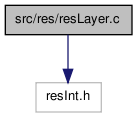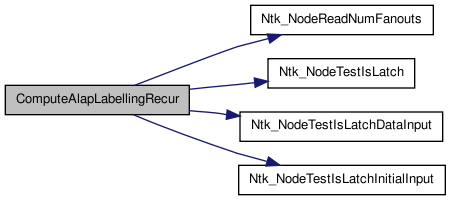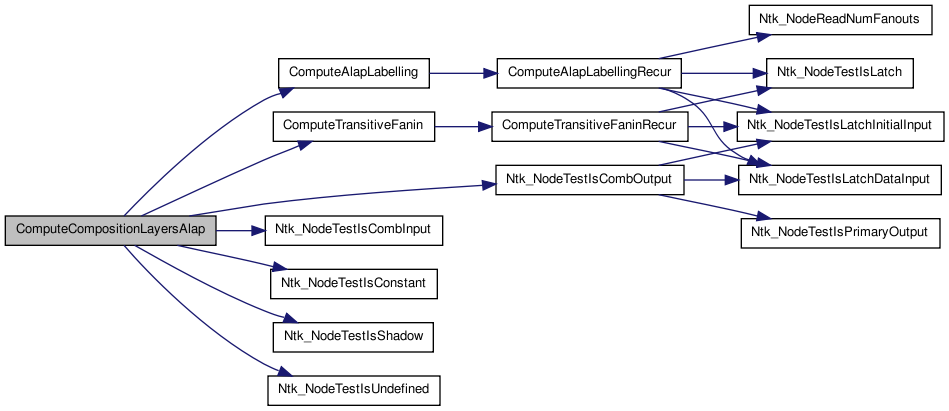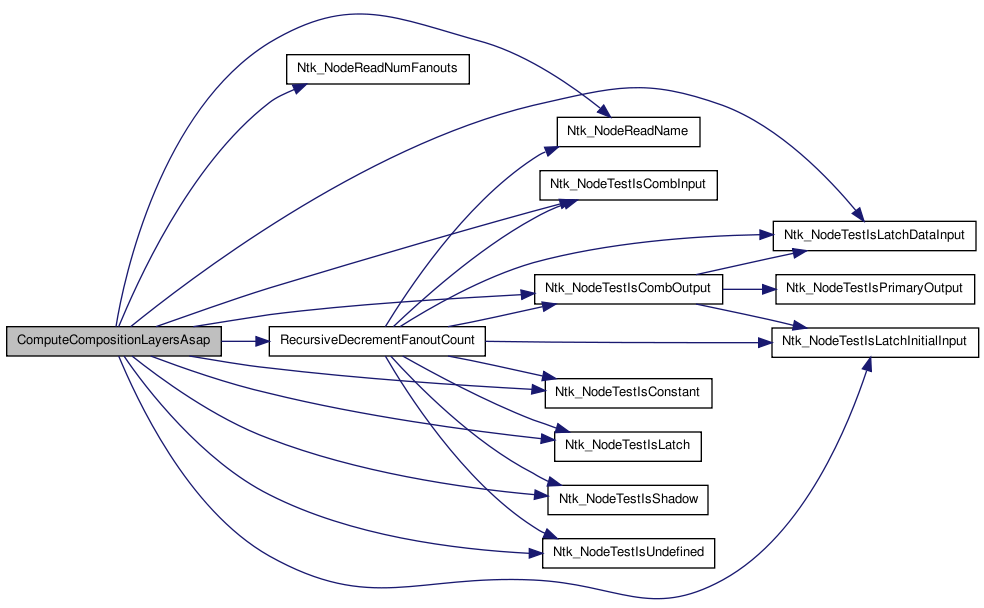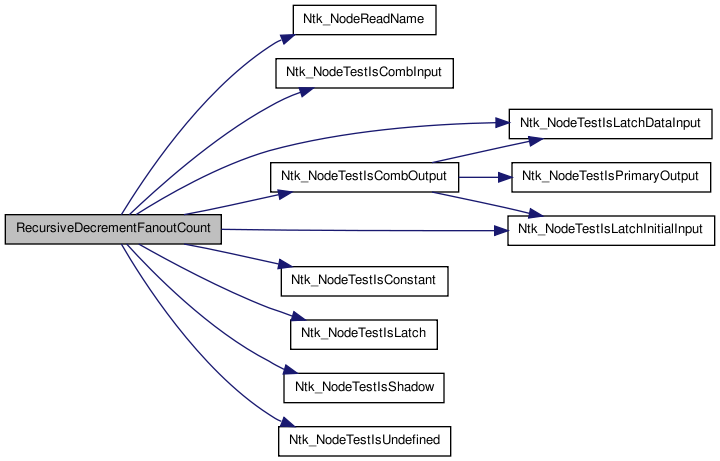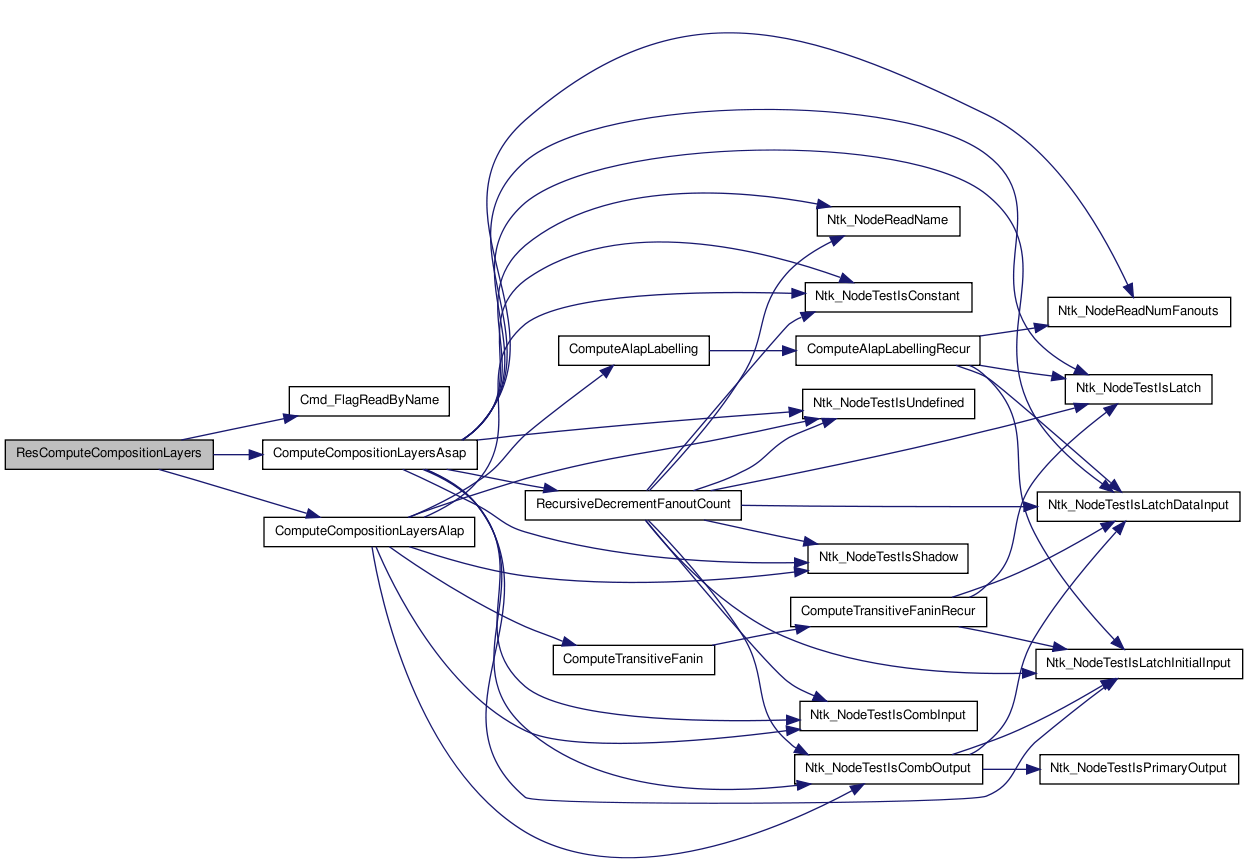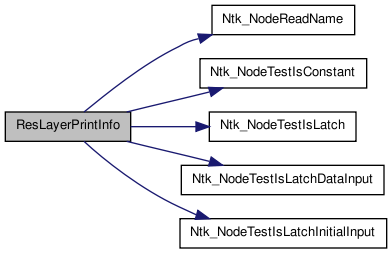#include "resInt.h" Include dependency graph for resLayer.c:
Include dependency graph for resLayer.c:Go to the source code of this file.
Functions | |
| static array_t * | ComputeCompositionLayersAsap (Ntk_Network_t *network, array_t *outputArray, array_t *ignoreArray) |
| static array_t * | ComputeCompositionLayersAlap (Ntk_Network_t *network, array_t *outputArray, array_t *ignoreArray) |
| static int | ComputeAlapLabelling (Ntk_Network_t *network, st_table *nodeLabelling) |
| static void | ComputeAlapLabellingRecur (Ntk_Node_t *node, st_table *nodeLabelling) |
| static st_table * | ComputeTransitiveFanin (array_t *outputArray) |
| static void | ComputeTransitiveFaninRecur (Ntk_Node_t *nodePtr, st_table *faninTable) |
| static void | RecursiveDecrementFanoutCount (Ntk_Node_t *nodePtr, st_table *fanoutCountTable, st_table *visitedTable) |
| array_t * | ResComputeCompositionLayers (Ntk_Network_t *network, array_t *outputArray, array_t *ignoreArray) |
| void | ResLayerPrintInfo (Ntk_Network_t *network, array_t *layerArray) |
| void | ResLayerArrayFree (array_t *layerArray) |
Variables | |
| static char rcsid[] | UNUSED = "$Id: resLayer.c,v 1.36 2005/04/16 07:31:03 fabio Exp $" |
Function Documentation
| static int ComputeAlapLabelling | ( | Ntk_Network_t * | network, |
| st_table * | nodeLabelling | ||
| ) | [static] |
Function*********************************************************************
Synopsis [ Procedure to label each node with its maximum distance from the primary inputs.]
Description [The procedure processes iteratively every input. For each of them, it labels recursively its transitive output keeping always the larger depth value. The procedure accepts as arguments the network that need to be labeled and a table with the labeling of nodes to be filled) and returns the maximum layer size.]
SideEffects [It modifies the st_table passed as parameter.]
SeeAlso [ComputeCompositionLayersAlap ComputeAlapLabellingRecur]
Definition at line 532 of file resLayer.c.
{
Ntk_Node_t *nodePtr; /* Node being processed */
lsGen gen; /* For list traversal */
int numLayers; /* To return as result */
int outputDepth; /* Depth of the output being processed */
assert(nodeLabelling != NIL(st_table));
/* For primary inputs in the table (those not in the table
* are in the transitive fanin of the ignored outputs only
*/
Ntk_NetworkForEachCombInput(network, gen, nodePtr) {
/* do it for fanouts that are in table only */
if (st_is_member(nodeLabelling, (char *)nodePtr)) {
ComputeAlapLabellingRecur(nodePtr, nodeLabelling);
}
}
/* Compute the number of layers */
numLayers = 0;
Ntk_NetworkForEachCombOutput(network, gen, nodePtr) {
/* only those outputs not be to be ignored */
if (st_lookup_int(nodeLabelling, (char *)nodePtr, &outputDepth)) {
if (outputDepth > numLayers ) {
numLayers = outputDepth;
} /* End of if */
}
}
return numLayers;
} /* End of ComputeAlapLabelling */
 Here is the call graph for this function:
Here is the call graph for this function: Here is the caller graph for this function:
Here is the caller graph for this function:| static void ComputeAlapLabellingRecur | ( | Ntk_Node_t * | node, |
| st_table * | nodeLabelling | ||
| ) | [static] |
Function*********************************************************************
Synopsis [Recursive procedure to label every node with its maximum depth from the primary inputs.]
Description [It labels every node with the current depth and proceeds recursively through the fanouts. The procedure accepts as its arguments the node it is currently recurring on and the table with labeling of the nodes(max distance from the PIs) which gets updated.]
SideEffects [It modifies the st_table passed as parameter]
SeeAlso [ComputeAlapLabelling]
Definition at line 583 of file resLayer.c.
{
Ntk_Node_t *fanoutPtr;
int nodeDepth;
int fanoutDepth;
int i;
/* Trivial case */
if (Ntk_NodeReadNumFanouts(node) == 0) {
return;
} /* End of if */
/* Look up information for the current node */
st_lookup_int(nodeLabelling, (char *)node, &nodeDepth);
/* Iterate over its fanouts */
Ntk_NodeForEachFanout(node, i, fanoutPtr) {
/* Do not process as soon as an input is found beyond an output */
if (!((Ntk_NodeTestIsLatchDataInput(node) ||
Ntk_NodeTestIsLatchInitialInput(node)) &&
Ntk_NodeTestIsLatch(fanoutPtr))) {
if (st_is_member(nodeLabelling, (char *)fanoutPtr)) {
/* Look up information for the fanout */
st_lookup_int(nodeLabelling, (char *)fanoutPtr, &fanoutDepth);
/* If the fanout depth needs to be modified, do so, and recur */
if (nodeDepth >= fanoutDepth) {
st_insert(nodeLabelling, (char *)fanoutPtr,
(char *)(long)(nodeDepth + 1));
ComputeAlapLabellingRecur(fanoutPtr, nodeLabelling);
} /* End of if */
} /* End of if */
} /* End of if */
} /* End of for each fanout */
return;
} /* End of ComputeAlapLabellingRecur */
 Here is the call graph for this function:
Here is the call graph for this function: Here is the caller graph for this function:
Here is the caller graph for this function:| static array_t * ComputeCompositionLayersAlap | ( | Ntk_Network_t * | network, |
| array_t * | outputArray, | ||
| array_t * | ignoreArray | ||
| ) | [static] |
Function**********************************************************************
Synopsis [ Computes the layers of nodes of the network based on the "as late as possible" heuristic.]
Description [ Computes the layers of nodes of the network based on the "as late as possible" heuristic. When composing an Add with nodes starting from the primary outputs, to the primary inputs, several nodes in the network are candidates for composition simultaneously producing what we decided to call "layers". This procedure schedules the composition of the nodes as late as possible under the "One-Time Rule" restriction. The One-Time Rule states that a node may be composed into the ADD only when all its fanouts have been composed in. This procedure schedules the composition of the nodes as "late" as possible i.e. only when no further composition can be done without composing the node in question. The order of composition is computed by labeling every node with its maximum distance from the primary inputs. The nodes are then scheduled starting with those with the larger depth and descending until reaching the inputs. Note that with this heuristic we still guarantee that every node appears in one single layer, therefore, it is only composed once. This is not "strictly as late as possible" as the symmetric opposite of the as soon as possible technique. But this scheduling has the additional win of taking advantage of the varying depths of the different paths in the circuit and scheduling the nodes evenly. The procedure takes as arguments the network whose layers are required, the outputs to be considered and the outputs to be ignored.]
SideEffects []
SeeAlso [ResComputeCompositionLayers ComputeCompositionLayersAsap]
Definition at line 445 of file resLayer.c.
{
Ntk_Node_t *nodePtr; /* node being processed */
array_t *layerArray; /* array of layers */
array_t *currentLayer; /* layer of nodes */
st_table *nodeLabelling; /* labeling of a node, its farthest distance
* from the primary input
*/
int numLayers; /* Number of Layers */
int layerIndex; /* index of a layer (from the primary output */
int arrayIndex; /* iterator */
st_generator *stGen; /* generator to step through table */
char *key; /* values to read from table */
int value; /* integer value to read from the table */
/* Initialize the labeling table */
nodeLabelling = ComputeTransitiveFanin(outputArray);
/* Compute the labeling of the nodes */
numLayers = ComputeAlapLabelling(network, nodeLabelling);
/* Create the layerArray structure */
layerArray = array_alloc(array_t *, numLayers);
/* initialize layers */
for (layerIndex = 0; layerIndex < numLayers; layerIndex++) {
currentLayer = LayerCreateEmptyLayer();
array_insert(array_t *, layerArray, layerIndex, currentLayer);
} /* end of for */
/* insert elements of the st_table in the layers */
st_foreach_item_int(nodeLabelling, stGen, &key, &value) {
layerIndex = value;
nodePtr = (Ntk_Node_t *)key;
/* don't put PIs or comb inputs or constants or undefined
* nodes in layer array
*/
if ((Ntk_NodeTestIsCombOutput(nodePtr)) ||
((layerIndex > 0) &&
!(Ntk_NodeTestIsCombInput(nodePtr) ||
Ntk_NodeTestIsConstant(nodePtr) ||
Ntk_NodeTestIsUndefined(nodePtr) ||
Ntk_NodeTestIsShadow(nodePtr)))) {
/* the layers are arranged in reverse order of their farthest
* distance from the node. Hence each node is inserted into
* the numLayers-1-layerIndex. Nodes with layerIndex should be
* put in the last array since they are probably constants
* at the primary outputs or latch initial value. LayerIndex
* could be 0 for primary outputs if it does not appear in the
* transitive fanin of the comb inputs.
*/
if (layerIndex == 0) {
arrayIndex = 0;
assert(Ntk_NodeTestIsCombOutput(nodePtr) == 1);
} else {
arrayIndex = numLayers - layerIndex;
}
currentLayer = array_fetch(array_t *, layerArray, arrayIndex);
LayerAddNodeAtEnd(currentLayer, nodePtr);
}
}
/* Clean up */
st_free_table(nodeLabelling);
return layerArray;
} /* End of ComputeCompositionLayersAlap */
 Here is the call graph for this function:
Here is the call graph for this function: Here is the caller graph for this function:
Here is the caller graph for this function:| static array_t * ComputeCompositionLayersAsap | ( | Ntk_Network_t * | network, |
| array_t * | outputArray, | ||
| array_t * | ignoreArray | ||
| ) | [static] |
AutomaticStart
Function********************************************************************
Synopsis [Computes the layers of nodes of the network based on the "as soon as possible" heuristic.]
Description [Computes the layers of nodes of the network based on the "as soon as possible" heuristic. When composing an Add with nodes starting from the primary outputs, to the primary inputs, several nodes in the network are candidates for composition simultaneously producing what we decided to call "layers". This procedure schedules the composition of the nodes as soon as possible under the "One-Time Rule" restriction. The One-Time Rule states that a node may be composed into the ADD only when all its fanouts have been composed in. The "as soon as possible" schedule is such that a node n is composed with its fanin nodes f1,...,fn AS SOON AS all its fanouts have been composed. The procedure returns an array of layers. Each node appears in only one layer. The procedure takes as arguments the network whose layers are required, the outputs to be considered and the outputs to be ignored.]
SideEffects []
SeeAlso [Res_NetworkResidueVerify ComputeCompositionLayersAlap]
Definition at line 264 of file resLayer.c.
{
Ntk_Node_t *nodePtr, *faninNodePtr; /* variables to store node pointers */
int i, j, k; /* iterators */
st_generator *stGen; /* generator to step through st_table */
char *key; /* values to read from st_table */
lsGen listGen; /* list generator to step through nodes */
array_t *currentLayer, *nextLayer; /* array of nodes belonging to a layer */
array_t *layerArray; /* array of layers */
st_table *fanoutCountTable; /* table to store fanout counts of each
* node
*/
int fanoutCount; /* variable to store fanout count of a
* node
*/
int value; /* to read value off the st_table */
st_table *visitedTable; /* table to store visited nodes */
/* create a fanout count table starting with all nodes except PIs,
* constant node or a shadow node for any node but a latch(counts as
* comb output).
*/
fanoutCountTable = st_init_table(st_ptrcmp, st_ptrhash);
Ntk_NetworkForEachNode(network, listGen, nodePtr) {
/* does not nodes like PIs, shadow nodes, constants, undefined
* nodes to compute the fanouts, since they do not have to be
* composed into the circuit.
*/
if ((Ntk_NodeTestIsCombOutput(nodePtr)) ||
(!(Ntk_NodeTestIsCombInput(nodePtr) ||
Ntk_NodeTestIsConstant(nodePtr) ||
Ntk_NodeTestIsUndefined(nodePtr) ||
Ntk_NodeTestIsShadow(nodePtr)))) {
st_insert(fanoutCountTable, (char *)nodePtr,
(char *)(long)Ntk_NodeReadNumFanouts(nodePtr));
}
}
/* take out outputs in directly verified table, if so desired */
/* Assume ignore table has node pointers , reduce fanout count of
* transitive fanin of these nodes
*/
if (ignoreArray != NULL) {
visitedTable = st_init_table(st_ptrcmp, st_ptrhash);
arrayForEachItem(Ntk_Node_t *, ignoreArray, i, nodePtr) {
/* each key is an output node */
RecursiveDecrementFanoutCount(nodePtr, fanoutCountTable, visitedTable);
}
st_free_table(visitedTable);
/* remove all nodes that are primary inputs and those with fanout
* count 0 providing they are not primary outputs/ or latch inputs
* or latch initial values.
*/
st_foreach_item_int(fanoutCountTable, stGen, &key, &value) {
fanoutCount = value;
nodePtr = (Ntk_Node_t *)key;
assert(fanoutCount >= -1);
if ((!Ntk_NodeTestIsCombOutput(nodePtr))
&& (fanoutCount <= 0)) {
/* delete the item corresponding to fanoutCount i.e. value */
st_delete_int(fanoutCountTable, (char **)&key, &value);
}
}
/* remove all outputs that belong to ignore outputs */
arrayForEachItem(Ntk_Node_t *, ignoreArray, i, nodePtr) {
st_delete_int(fanoutCountTable, &nodePtr, &value);
}
}
/* start preparing the layer array */
layerArray = array_alloc(array_t *, 0);
currentLayer = LayerCreateEmptyLayer();
/* outputs form the first layer */
Ntk_NetworkForEachCombOutput(network, listGen, nodePtr) {
if (st_lookup_int(fanoutCountTable, (char *)nodePtr, &fanoutCount)) {
/* insert all outputs that aren't to be ignored in the first layer of the
* layer array
*/
LayerAddNodeAtEnd(currentLayer, nodePtr);
}
}
/* if current layer is not empty */
while (ResLayerNumNodes(currentLayer) ) {
/* insert current layer into layer array */
array_insert_last(array_t *, layerArray, currentLayer);
nextLayer = LayerCreateEmptyLayer();
LayerForEachNode(currentLayer, i, nodePtr) {
Ntk_NodeForEachFanin(nodePtr, j, faninNodePtr) {
/* do not want to get the fanin for latch outputs */
if(!(Ntk_NodeTestIsConstant(nodePtr) ||
(Ntk_NodeTestIsLatch(nodePtr) &&
(Ntk_NodeTestIsLatchDataInput(faninNodePtr) ||
Ntk_NodeTestIsLatchInitialInput(faninNodePtr))))) {
if (!st_lookup_int(fanoutCountTable, (char *)faninNodePtr,
&fanoutCount)) {
/* maybe it is a PI or constant node */
if (!(Ntk_NodeTestIsCombInput(faninNodePtr) ||
Ntk_NodeTestIsConstant(faninNodePtr) ||
Ntk_NodeTestIsUndefined(faninNodePtr) ||
Ntk_NodeTestIsShadow(faninNodePtr))) {
error_append("Fanin node %s should have been in table");
error_append(Ntk_NodeReadName(faninNodePtr));
/* Cleanup */
arrayForEachItem(array_t *, layerArray, k, currentLayer) {
LayerFree(currentLayer);
}
array_free(layerArray);
return NIL(array_t);
} /* node is neither PI nor constant */
} else { /* node is found in table */
fanoutCount--;
/* decrement fanout count, will go into a later layer */
if (fanoutCount == 0) {
/*
* it is ready to be put in the array,
* since its fanout count is 1
*/
LayerAddNodeAtEnd(nextLayer, faninNodePtr);
} else if (fanoutCount > 0) {
/* insert new decremented value in table */
st_insert(fanoutCountTable, (char *)faninNodePtr,
(char *)(long)fanoutCount);
} /* end of nodes fanout count larger than 1 */
} /* end of fanin node found in fanout count table */
} /* do not want to get the fanin for latch outputs */
} /* end of iteration through all the fanin nodes of current node */
} /* end of iteration through all the nodes of current layer */
/* the fanout count ensures unique entry of elements ????*/
currentLayer = nextLayer;
} /* end of while some nodes in current layer */
/* the loop always exits with an empty array */
LayerFree(currentLayer);
st_free_table(fanoutCountTable);
if (array_n(layerArray) == 0) {
array_free(layerArray);
layerArray = NIL(array_t);
}
return (layerArray);
} /* End of ComputeCompositionLayersAsap */
 Here is the call graph for this function:
Here is the call graph for this function: Here is the caller graph for this function:
Here is the caller graph for this function:| static st_table * ComputeTransitiveFanin | ( | array_t * | outputArray | ) | [static] |
Function*********************************************************************
Synopsis [Procedure that computes the transitive fanin of a set of nodes in an array.]
Description [[Procedure that computes the transitive fanin of a set of nodes in an array. The procedure puts the nodes themselves into the array too.The procedure takes as arguments the array whose transitive fanin need to be computed and returns an st_table with the fanin.]
SideEffects []
SeeAlso [ComputeCompositionLayersAlap ComputeTransitiveFaninRecur]
Definition at line 638 of file resLayer.c.
{
Ntk_Node_t *nodePtr;
st_table * faninTable;
int i;
faninTable = st_init_table(st_ptrcmp, st_ptrhash);
arrayForEachItem(Ntk_Node_t *, outputArray, i, nodePtr) {
ComputeTransitiveFaninRecur(nodePtr, faninTable);
}
return faninTable;
} /* End of ComputeTransitiveFanin */
 Here is the call graph for this function:
Here is the call graph for this function: Here is the caller graph for this function:
Here is the caller graph for this function:| static void ComputeTransitiveFaninRecur | ( | Ntk_Node_t * | nodePtr, |
| st_table * | faninTable | ||
| ) | [static] |
Function*********************************************************************
Synopsis [Recursive procedure to compute the transitive fanin of a node.]
Description [ Recursive procedure to compute the transitive fanin of a node. After computing the transitive fanin, the node itself goes into the table. The procedure takes in as arguments the node it is recurring on and the table of fanin encountered.]
SideEffects []
SeeAlso [ComputeTransitiveFanin]
Definition at line 667 of file resLayer.c.
{
Ntk_Node_t *faninNodePtr;
int i;
if (st_lookup(faninTable, (char *)nodePtr, NIL(char *))) {
return;
}
/* recur on fanin nodes */
Ntk_NodeForEachFanin(nodePtr, i, faninNodePtr) {
/* Test this case cos other comb inputs have no fanins */
if (!((Ntk_NodeTestIsLatchDataInput(faninNodePtr) ||
Ntk_NodeTestIsLatchInitialInput(faninNodePtr)) &&
Ntk_NodeTestIsLatch(nodePtr))) {
ComputeTransitiveFaninRecur(faninNodePtr, faninTable);
} /* end of if */
} /* iterate over all fanins */
st_insert(faninTable, (char *)nodePtr, NIL(char));
return;
} /* End of ComputeTransitiveFaninRecur */
 Here is the call graph for this function:
Here is the call graph for this function: Here is the caller graph for this function:
Here is the caller graph for this function:| static void RecursiveDecrementFanoutCount | ( | Ntk_Node_t * | nodePtr, |
| st_table * | fanoutCountTable, | ||
| st_table * | visitedTable | ||
| ) | [static] |
Function*********************************************************************
Synopsis [Function to decrement fanout count]
Description [Recursive procedure that reduces the fanout count of the current node and recurs on its fanin. Stops when Pis or constant nodes are hit which have no fanins. The procedure takes in as arguments the current it is recurring on and the table with nodes and their fanout counts.]
SideEffects []
SeeAlso [ComputeCompositionLayersAsap]
Definition at line 708 of file resLayer.c.
{
Ntk_Node_t *faninNodePtr;
int i, fanoutCount;
/* the following kinds of nodes will not be in the table. */
if ((!Ntk_NodeTestIsCombOutput(nodePtr)) &&
(Ntk_NodeTestIsCombInput(nodePtr) ||
Ntk_NodeTestIsUndefined(nodePtr)||
Ntk_NodeTestIsConstant(nodePtr) ||
Ntk_NodeTestIsShadow(nodePtr))) {
return;
}
/* all nodes called here should exist in table */
if (!st_lookup_int(fanoutCountTable, (char *)nodePtr, &fanoutCount)){
error_append("Node ");
error_append(Ntk_NodeReadName(nodePtr));
error_append(" should have been in table\n");
return;
}
fanoutCount--;
/* reduce fanout count of node */
st_insert(fanoutCountTable, (char *)nodePtr, (char *)(long)fanoutCount);
/* if this node is visited, decrement its fanout but do not proceed
* any further (i.e. do not proceed with its fanins
*/
if (st_is_member(visitedTable, (char *)nodePtr)) {
return;
} else {
st_insert(visitedTable, (char *)nodePtr, NIL(char));
/*
* recur with fanin nodes except nodes with no fanins (that arent in table)
* and latch outputs
*/
Ntk_NodeForEachFanin(nodePtr, i, faninNodePtr) {
/* may be a redundant test, since it will pop out in the first line of
* the procedure anyways.
*/
if (!(Ntk_NodeTestIsConstant(faninNodePtr) ||
((Ntk_NodeTestIsLatchDataInput(faninNodePtr) ||
Ntk_NodeTestIsLatchInitialInput(faninNodePtr)) &&
Ntk_NodeTestIsLatch(nodePtr)))) {
RecursiveDecrementFanoutCount(faninNodePtr, fanoutCountTable, visitedTable);
}
} /* end of iterating over fanins */
} /* end of else if not visited */
return;
} /* End of RecursiveDecrementFanoutCount */
 Here is the call graph for this function:
Here is the call graph for this function: Here is the caller graph for this function:
Here is the caller graph for this function:| array_t* ResComputeCompositionLayers | ( | Ntk_Network_t * | network, |
| array_t * | outputArray, | ||
| array_t * | ignoreArray | ||
| ) |
AutomaticEnd Function********************************************************************
Synopsis [Computes the layers of nodes of the network that represent the order for composition.]
Description [ Computes the layers of nodes of the network that represent the order for composition. When composing an ADD with nodes in the circuit starting with the primary outputs, several nodes in the network can be composed at the same time producing "layers" in the network. When a node is in the layer and it is composed with its fanin nodes, the original node does not belong to the ADD any more, and its fanin nodes become now part of the ADD. There are several ways to produce this cut, we provide two such methods. This procedure reads the flag residue_layers<> and calls the pertinent function. The procedure takes as arguments the network whose layers need to be formed, the set of outputs that need to be considered and the set of outputs that can be ignored. The procedure returns an array of layers]
SideEffects []
SeeAlso [ComputeCompositionLayersAsap ComputeCompositionLayersAlap]
Definition at line 92 of file resLayer.c.
{
ResLayerScheduleMethod layerMethod; /* read from the set value */
array_t *result; /* Result obtained from procedure */
char *flagValue; /* To store the value read from the flag */
/* Read the value from the flag */
flagValue = Cmd_FlagReadByName("residue_layer_schedule");
if (flagValue == NIL(char)) {
layerMethod = ResDefaultScheduleLayerMethod_c;
}
else {
if (strcmp(flagValue, "asap") == 0) {
layerMethod = ResLayerAsap_c;
}
else if (strcmp(flagValue, "alap") == 0) {
layerMethod = ResLayerAlap_c;
}
else {
(void) fprintf(vis_stderr, "** res error: Unknown method to compute layers.");
(void) fprintf(vis_stderr, "** res error: Assuming default method.\n");
layerMethod = ResDefaultScheduleLayerMethod_c;
}
}
/* Call the pertinent procedure */
switch (layerMethod) {
case ResLayerAlap_c: {
result = ComputeCompositionLayersAlap(network, outputArray, ignoreArray);
break;
}
case ResLayerAsap_c: {
result = ComputeCompositionLayersAsap(network, outputArray, ignoreArray);
break;
}
default: {
(void) fprintf(vis_stdout, "** res warning: Layer computation method not implemented.");
(void) fprintf(vis_stdout, "** res warning: Executing default method.\n");
result = ComputeCompositionLayersAlap(network, outputArray, ignoreArray);
break;
}
}
return result;
} /* End of ResComputeCompositionLayers */
 Here is the call graph for this function:
Here is the call graph for this function: Here is the caller graph for this function:
Here is the caller graph for this function:| void ResLayerArrayFree | ( | array_t * | layerArray | ) |
Function********************************************************************
Synopsis [Free the layer information computed for each network.]
Description [Free the layer information computed for each network. Takes the layer structure to be freed as the argument.]
SideEffects []
SeeAlso [Res_NetworkResidueVerify]
Definition at line 222 of file resLayer.c.
{
int i, end;
array_t *currentLayer;
i = 0;
end = array_n(layerArray);
for (i =0; i < end ; i++) {
currentLayer = ResLayerFetchIthLayer(layerArray, i);
LayerFree(currentLayer);
}
array_free(layerArray);
} /* End of ResLayerArrayFree */
 Here is the caller graph for this function:
Here is the caller graph for this function:| void ResLayerPrintInfo | ( | Ntk_Network_t * | network, |
| array_t * | layerArray | ||
| ) |
Function********************************************************************
Synopsis [Prints out the different layers in the circuit.]
Description [Prints the nodes in various layers starting with the output along with their layer numbers. The procedure also counts the number of new variables that the current layer brings in. The procedure takes the network whose layers are to be printed and the layer array structure.]
SideEffects []
SeeAlso [Res_NetworkResidueVerify]
Definition at line 156 of file resLayer.c.
{
Ntk_Node_t *nodePtr, *faninNodePtr; /* Node being processed */
st_table *faninTable; /* Current nodes */
int layerIndex, newVars; /* index of the layer being processed */
int i,j; /* For array traversal */
array_t *currentLayer; /* layer info */
/* keep track of all nodes that have appeared in the support */
faninTable = st_init_table(st_ptrcmp, st_ptrhash);
/* Loop over the number of elements in layerArray */
for (layerIndex = 0; layerIndex < array_n(layerArray); layerIndex++) {
/* reset new variables in the support of this array */
newVars = 0;
(void) fprintf(vis_stdout, "Layer %d: ", layerIndex);
/* Access the layer info */
currentLayer = ResLayerFetchIthLayer(layerArray, layerIndex);
/* Print the nodes in a layer that are not PIs */
LayerForEachNode(currentLayer, i, nodePtr) {
(void) fprintf(vis_stdout, "%s ", Ntk_NodeReadName(nodePtr));
/* store fanin nodes in the table, keep count */
Ntk_NodeForEachFanin(nodePtr, j, faninNodePtr) {
if (!st_is_member(faninTable, (char *)faninNodePtr)) {
if (!((Ntk_NodeTestIsLatch(nodePtr) &&
(Ntk_NodeTestIsLatchDataInput(faninNodePtr) ||
Ntk_NodeTestIsLatchInitialInput(faninNodePtr))) ||
Ntk_NodeTestIsConstant(faninNodePtr))) {
st_insert(faninTable, (char *)faninNodePtr, NIL(char));
newVars++;
}
}
}
}
(void) fprintf(vis_stdout,": SUPPORT = %d", newVars);
(void) fprintf(vis_stdout, "\n");
} /* End of for every layer */
/* Clean up */
st_free_table(faninTable);
return;
} /* End of ResLayerPrintInfo */
 Here is the call graph for this function:
Here is the call graph for this function: Here is the caller graph for this function:
Here is the caller graph for this function:Variable Documentation
char rcsid [] UNUSED = "$Id: resLayer.c,v 1.36 2005/04/16 07:31:03 fabio Exp $" [static] |
CFile***********************************************************************
FileName [resLayer.c]
PackageName [res]
Synopsis [This file is responsible for computing the "layers" in a circuit depending on the method]
Author [Kavita Ravi <ravi@boulder.colorado.edu> and Abelardo Pardo <abel@boulder.colorado.edu>]
Copyright [This file was created at the University of Colorado at Boulder. The University of Colorado at Boulder makes no warranty about the suitability of this software for any purpose. It is presented on an AS IS basis.]
Definition at line 21 of file resLayer.c.
